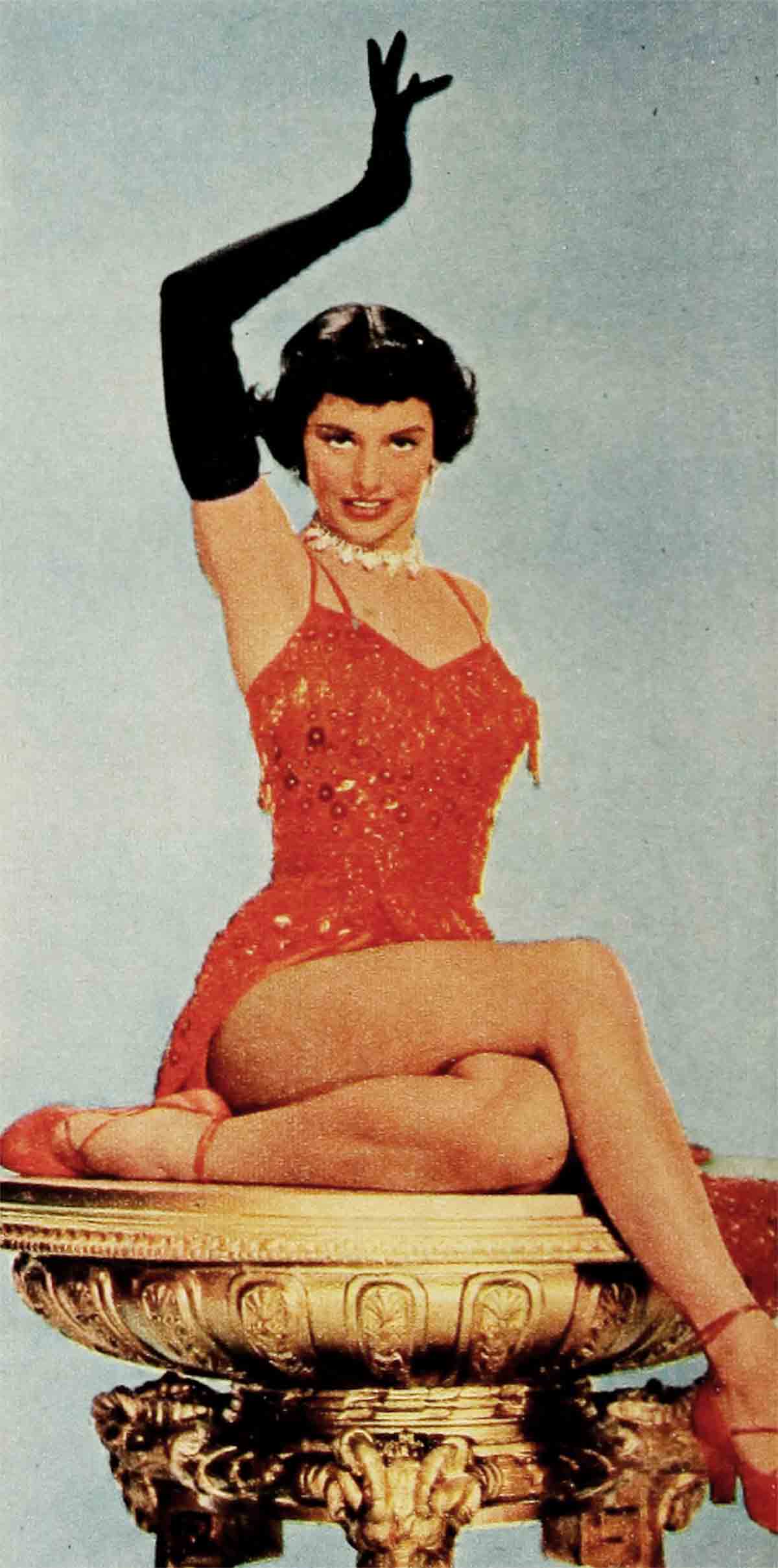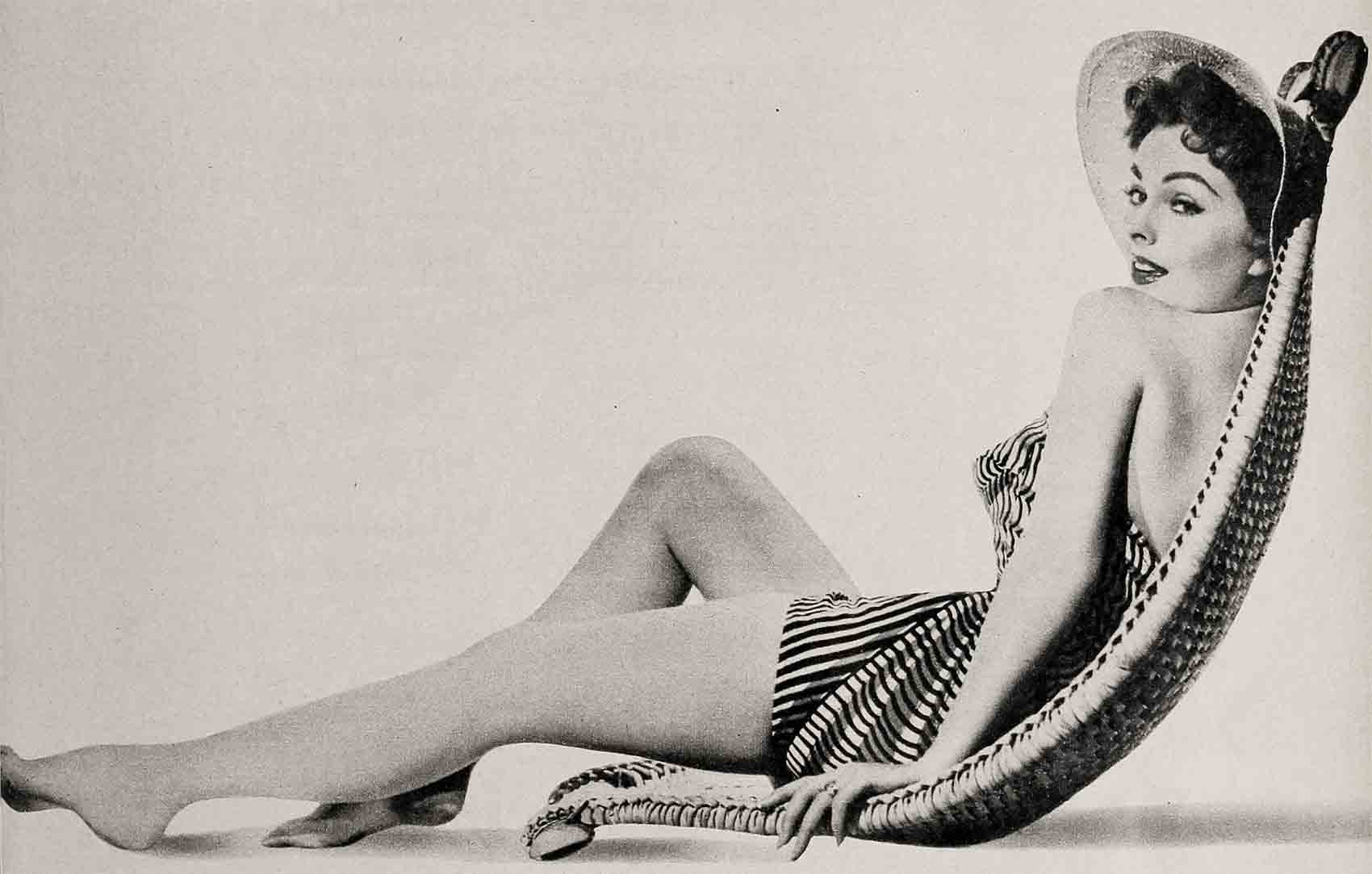
Hollywood’s Beauty Fair
An astute Hollywood observer recently remarked, “Really beautiful people are beautiful all over. Not just their faces and their bodies. Look at their hands, their feet, the way their heads are shaped and the way they move.” Truer words were never spoken of these girls who grace MODERN SCREEN’s Beauty Fair, chosen by our editors and readers as models of real loveliness. They are beautiful all over—in different ways.

Some are simply born to that desirable state of being and never have to lift a finger to remain there. Like Grace Kelly. She was born of a lovely mother; her father and her brother, millionaire John Kelly and Scull Champion Jack Kelly, Jr., could run away with a contest for the most handsome father-and-son team. How could the girl miss? She started from scratch with the pulchritude, and all she has had to do to enhance its ethereal quality is to be herself—tranquil, fastidious, elegant. “She’s all of that,” said a dazzled swain. “Bnd she projects more zing than a dozen more obvious women put together!”

Another well-known projector who’s just doin’ what comes naturally is Jane Russell. You can have a hassle with people who know all of the Russells on the subject of beauty. “By Hollywood standards she’s as beautiful as they come, but when I think of her mother and brothers, I’m not sure that Jane’s the best looking of the lot. You should see the boys!” says one of Jane’s friends.
“Her loveliness I never knew until she smiled at me.” wrote a poet. Behind the coloring, bone structure, perfect measurements of each of these lovely ladies lies a unique inward beauty.
What does she do to keep the beauty that is possibly second or third best in her family? That required a little thought, because who can safely say why Miss Russell does anything at any time? “Well, she gets nine hours of sleep every night,” her friend offered tentatively, “but I honestly don’t think that it’s to preserve her looks. She’s just tired. Anyhow, with her heritage it wouldn’t matter what she did. If she went to bed with her make-up on, her skin would stay as smooth; if she wore her hair in a knot on top of her head all day, she could brush it out and it would look better than the rest of us if we have been up in pin curls. She even looks good when she wakes up in the morning.”
Jane’s other beauty secrets include working too hard, fighting other people’s battles, and taking the problems of the world onto her own sleek shoulders. She ought to look like a hag for all of the attention that she gives herself, instead of which she joins the lovelies of the Beauty Fair. “Sultry, smouldering, the slow-fire type,” is the masculine verdict on Jane. “But you also know that you’d have a ball on a fishing trip with her. She’s a wonderful pal as well as a beautiful woman.”

Elizabeth Taylor had a problem in her younger days: she was too beautiful. When she appeared on the set of one of her first pictures, the director cast an outraged eye at this incredible child and roared, “Take her back to make-up and get those eyelashes off her. She’s too young for that sort of thing!” It would have been pretty painful, considering that the offending eyelashes were her very own, but this misunderstanding was only one of the indignities that Liz had to suffer, Silly as it sounds today, looking at dainty Miss Taylor, she had to be taught to wear feminine clothes. She was such a tree-climbing tomboy that when she was trapped in a dress, the awkwardness she felt was apparent.

It could have been—should have been—about Cyd Charisse that our observer said, “Everything is perfect.” From head to toe there is such unbelievable symmetry of face and form that watching her move is pure delight. The hands that are as expressive as her face. the incomparable legs, the fluid economy of motion are such that they often hit her audience after she has quietly passed. They are apt to say, “Holy cow, wasn’t that a radiant girl!”
A presumably case-hardened publicist explained Cyd this way: “Crazy as it probably sounds to you, I have the feeling that her mind and soul are as symmetrical as her body. She does everything exactly right because she can’t help it. It’s natural to her, a part of the way she lives. Even her life unfolds with the same grace that characterizes everything she does—and that doesn’t just happen, you know.”

Speaking of grace inevitably brings to mind Ava Gardner, who would stand out on anyone’s poll of beautiful women. Again the man behind the lens said, “When people speak of Ava, they generally refer to that gorgeous body—which makes sense. Other girls may have put the wiggle on the map, but Ava’s got the sexiest walk that ever happened, because it’s so lithe and effortless. But I’ve got news for you: this girl has one of the most beautiful faces I’ve ever seen in fifteen years of photographing movie stars. Hair, eyes, nose, skin, bone structure—she’s got ’em with chimes. Highlight that face correctly, and a more beautiful woman never lived.”
Nor a more glamorous one—but that came with time. When Ava descended on Hollywood, her painful shyness was an enormous liability. With great beauty there must also be an air, an awareness of self and of the proud, exciting aura of glamour. The young Ava sadly lacked it. The physical splendor was there, but Ava was so timid and retiring in the beginning that she all but went unnoticed until she commenced to emerge, little by little, like a butterfly from its chrysalis. In time confidence gave her that necessary proud air, but simple good sense preserves the natural beauty. Ava is the soap-and-water girl of all time, the most vigorous wielder of the bedtime hairbrush.
Those who are close to Rhonda Fleming insist that her inner beauty is far greater than that which gratifies the eye. Her business manager, Anetta Hughes, says, “I’ve been with Rhonda more than five years, and I have yet to hear her express an unkind opinion of anybody or do an unkind deed. She always thinks wholesome thoughts.”

This long-stemmed beauty of the. flaming tresses is a firm believer in moderation. If she nibbles at a cookie or two, she will have a smaller helping of potatoes at her next meal, even though her weight never varies. It’s a matter of principle. She does setting-up exercises, but not fanatically. She enjoys swimming and playing tennis with her husband, Lew Morrill, but her world will not fall apart if a few days lapse without her doing either. She enjoys oil painting, at which she has displayed some talent, but only when she has time. Her glowing skin is regularly exposed to soap and water, but Rhonda doesn’t go overboard on that score, either. She is meticulous about removing every vestige of make-up with cold cream before retiring at night. She makes a big effort to be orderly and usually succeeds—but when she is rushed, things do fly.
Three things she does not do in moderation. The first is to love humanity (although she had to overcome her native shyness). The second is to read; she is a quick and retentive reader who can go through an average script in an hour. The third. is to sleep, Like Jane Russell, she can’t do with less than eight hours nightly and feels better with a little more. And she is more than moderately beautiful.
Still, as we said, people in Hollywood tend to think of beauties only in one way or another. They remark on the bewitching, gamin face of Jean Simmons, notwithstanding the fact that quite a body goes along with the face. Or they speak of Ava Gardner’s magnificent body as though her ravishing face is superfluous. Our last entry in the Beauty Fair turned the tables on people half-blinded by beauty. For years Jeanne Crain was famous for the classic beauty of her face, the limpid innocence of her eyes, the sweet gravity of her mouth. And so they thought of her. Oh, they knew that she had an uncontrollable desire to play practical jokes, but they practically heard the whisper of angel wings when Jeanne Crain walked by.

It took even an intelligent girl like Jeanne a while to get bored by being thought of and cast as Little Goody TwoShoes, but bored she got. Off came the long, girlish locks that seemed to belie the knowledge that she was a mature mother of four; she emerged with a sophisticated Italian-boy cut—and what hair there was left was purely red! A little of the devil that is in all the Irish danced in her eyes, lurked in the corners of her smile. The demure costumes disappeared; Jeanne Crain posed for cheesecake, yet, and it hit the town between the eyes that this girl had attributes other than a classically beautiful face.
It tickled her pink, humor being one of Jeanne’s assets. She had fooled the town that knew everything about glamour. And how does she go about maintaining beauty of feature and of form? Little Jeannie Crain has a formula that might well be hers alone. High on a hill Paul Brinkman has built her a small studio, where she goes to paint, to read, to meditate. She likes to go there, also, to swim at midnight. There is something about the water and the atmosphere at that hour, she says, that relaxes her, gives her the balance and composure without which no woman alive can be beautiful.
THE END
(These MODERN SCREEN Beauties Fair can be seen in these movies:
Grace Kelly—Green Fire—MGM 30th anniversary release, Dial M for Murder— Warner Bros., Rear Window—Paramount
Jane Russell—The Big Rainbow—RKO
Elizabeth Taylor—Beau Brummel—MGM 30th anniversary release
Cyd Charisse—Brigadoon—MGM 30th anniversary release
Ava Gardner—The Barefoot Contessa— MGM 30th anniversary release
Rhonda Fleming—Yankee Pasha—U-I
Jeanne Crain—Duel In The Jungle—Moulin Rouge Prod.)
It is a quote. MODERN SCREEN MAGAZINE JUNE 1954




